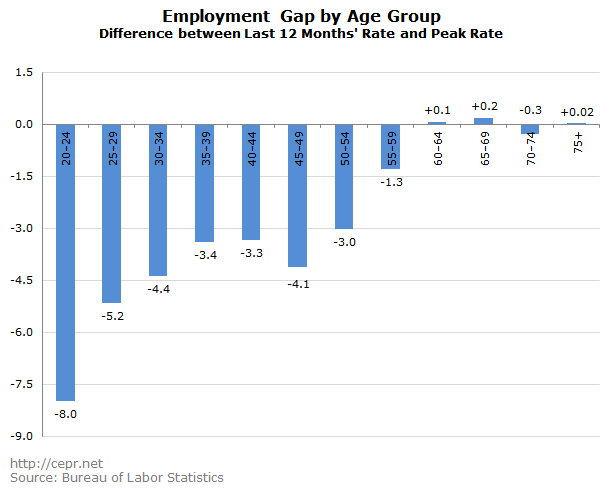June 13, 2016
CEPR recently released a blog post titled “Maximum Potential Employment and the Jobs Gap.” The post asked two simple questions:
-
1. How high could the employment rate go given the current age composition of the population?
-
2. How large is the gap between this potential employment rate and the actual employment rate?
The post concluded that although the gap between actual and potential employment has declined since the end of the recession, it is nonetheless larger than it was before the recession.
The “maximum potential employment rate” used in the post was calculated by asking what the overall employment rate would be if each age group were to achieve its highest calendar-year employment rate at the same time. It is notable that the current jobs gap is due purely to low employment rates among younger workers. With the exceptions of the 45–49 and 70+ age groups, there is a consistent rule to be had in terms of job loss: employment has declined more significantly for younger workers than for older workers.
The figure below shows the difference between the peak calendar-year employment rate and the rate from May 2015 to April 2016 for each age group. For workers age 60 and over, employment is at an all-time high. By contrast, employment is down 8.0 percentage points for 20–24 year-olds, 5.2 percentage points for 25–29 year-olds, and 3.0–4.4 percentage points for workers aged 30–54.

Some of the decline in employment among 20–24 year-olds is due to higher college enrollment. Employment for 20–24 year-olds peaked at 72.2 percent in 2000; that year, less than 29 percent of Americans in their early twenties were enrolled in school. (Note that this is a year-round average, with enrollment being lower in the summer than in the other months.) Over the past year, a bit over 35 percent of 20–24 year-olds have been in school. Overall, higher matriculation has pushed down employment in this age group by 1.3 percentage points.[1] So while rising college enrollment has clearly played a role in pushing down employment for Americans in their early twenties, employment would have dropped over 6 percentage points regardless of rising enrollment rates.
It is clear that the 2001 and 2008 recessions did the most harm to younger workers. This should be of serious national concern: unemployment in workers’ formative years can leave “scarring effects” which throw off their entire career trajectories. A higher employment rate for young workers won’t just help the country today — it will improve the long-term health of the economy by giving young workers the best opportunities to improve their economic and professional lives.
[1] Specifically, 1.3 percentage points of the decline can be attributed to rising college enrollment; 6.3 percentage points can be attributed to declines in employment within groups (the groups being “those enrolled in school” and “those not enrolled in school”); and the remaining 0.4 percentage points are due to interaction effects.






